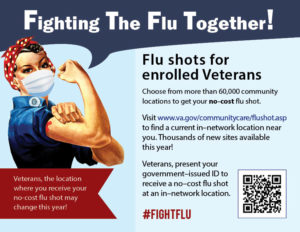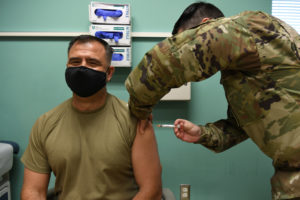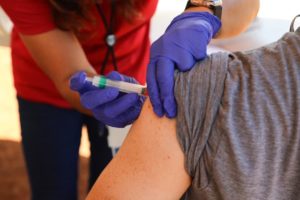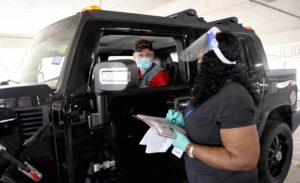
Hospital Corpsman 2nd Class Desiree Gee prepares a syringe with the influenza vaccine before administering annual flu shotsat Navy Medicine Readiness and Training Command Corpus Christi. Photo by Dale Davis of the Naval Health Clinic, Corpus Christi, TX.
DURHAM, NC — Public health officials across the country have warned that the combination of the COVID-19 pandemic and influenza could endanger a record number of Americans and overwhelm healthcare facilities this fall and winter. This risk for veterans, who tend to be older and have more comorbidities, is particularly high.
“Getting a flu vaccine this fall is more important than ever to protect yourself, your family, friends, and coworkers. We are facing a tough 2020 flu season as we prepare to battle the coronavirus at the same time,” said Jane Kim, MD, MPH, chief consultant for preventive medicine at the VA National Center for Health Promotion and Disease Prevention, Patient Care Services, based in Durham, NC.
In a major switch from previous years, the VA added coverage for high-dose flu shot for veterans age 65 and older to its previous policy offering the standard-dose immunization for all veterans.
The high-dose vaccine (Fluzone High-Dose) contains four times the amount of inactivated viral protein or antigen included in the standard-dose injection. It is approved specifically for individuals 65 and up because research has shown that immune response wanes as people age. The higher level of antigen stimulates a stronger immune response and greater protection against future infection. That’s particularly important for older patients as they account for 70% to 80% of flu-related deaths and 50% to 70% of hospitalizations related to influenza.
 Several studies have demonstrated that the high-dose vaccine does provide greater protection for this age group. A study of more than 30,000 people published in the New England Journal of Medicine found that patients the high-dose vaccine reduced influenza cases by 24% compared to the standard dose.1
Several studies have demonstrated that the high-dose vaccine does provide greater protection for this age group. A study of more than 30,000 people published in the New England Journal of Medicine found that patients the high-dose vaccine reduced influenza cases by 24% compared to the standard dose.1
Two large studies among veterans showed that the high-dose vaccine also reduced more serious complications and hospitalizations. An analysis of data from more than 1.7 million older veterans treated at 1,347 VA facilities over five flu seasons determined that the high-dose vaccine had 10% greater relative efficacy in preventing all-cause hospitalization, 18% greater efficacy in preventing cardiorespiratory-associated hospitalizations, and 14% greater efficacy in preventing influenza or pneumonia hospitalizations.1

Robert Padilla, 30th Health Care Operations Squadron aerospace medical technician, gives Col. Anthony Mastalir, 30th Space Wing commander, his annual flu shot at Vandenberg Air Force Base, CA. Photo by Staff Sgt. Brittany Murphy
A second study using the same data found the high-dose vaccine reduced costs associated with influenza-related hospitalizations by $202 per vaccinated veteran compared to the standard-dose vaccine.2
The high-dose vaccine available for the 2020 flu season protects against four strains of influenza. In prior years, the high-dose vaccine only included antigens for three strains. This year, the components in the quadrivalent standard-dose and high-dose vaccines are A/Guangdong-Maonan/SWL1536/2019 (H1N1) pdm09-like virus, A/Hong Kong/2671/2019 (H3N2)-like virus, B/Washington/02/2019 (B/Victoria lineage)-like virus, and B/Phuket/3073/2013-like (Yamagata lineage) virus.
Reducing Risk
The same steps that protect people from COVID-19—mask-wearing, social distancing, hand washing—also inhibit the spread of influenza. In explaining the unusually light flu season that just ended in the Southern Hemisphere, the national Centers for Disease Control and Prevention said, “[l]ike SARS-CoV-2, influenza viruses are spread primarily by droplet transmission; the lower transmissibility of seasonal influenza virus (R0 = 1.28) compared with that of SARS-CoV-2 (R0 = 2–3.5) (7) likely contributed to a more substantial interruption in influenza transmission.”

The VA Pacific Islands Healthcare System informed veterans on Oahu that they could get their flu shots at the Tripler Army Medical Center’s ball field drive thru. The photo shows vaccine being administered there. Photo from VA Pacific Island Healthcare System Facebook page..
Still, the CDC strongly recommends that “during the continued or recurrent circulation of SARS-CoV-2 concurrently with influenza viruses during the upcoming fall and winter, influenza vaccination of persons aged ≥6 months can reduce prevalence of illness caused by influenza, and can also reduce symptoms that might be confused with those of COVID-19.”
Reducing the impact of influenza on veterans this year is particularly important to VA healthcare facilities. “In the 2019-2020 flu season, more than 4,600 veterans were hospitalized at VA medical centers. More than 600 of them required intensive care stays. VA providers also saw over 27,000 veterans for flu and spoke to more than 13,000 during phone triage calls,” Kim said.
If, as the CDC anticipates, COVID-19 cases increase through the fall and winter, high rates of vaccination will make it easier for healthcare providers who need to discern whether a patient has influenza or a novel coronavirus infection, which can appear quite similar in early stages. That matters as treatments shown to be helpful for COVID-19, such as the corticosteroid dexamethasone, can make influenza worse. At the same time, the antivirals effective in influenza have shown no efficacy against the SARS-CoV-2 virus.
Individuals who have received their flu shots may also more quickly quarantine themselves if they begin to exhibit symptoms common to both infections, thereby potentially reducing spread of COVID-19. Flu vaccination will also reduce the risk of co-infection with both viruses, which increased the length of stay in hospitalized patients.
Accessing the Vaccine

Army Veteran Steven Gurchik talks with Veronica Nelson, LVN, before receiving his flu shot at the Dallas VAMC. VA North Texas patients are able to talk to a nurse, fill out the proper paperwork and get their immunization right from their vehicle. Photo from Sept. 15, 2020, VAntage Point blog.
VA healthcare facilities should have received half their allotment of influenza vaccine by mid-September and the balance by mid-October. Shots are available to veterans enrolled in the VA healthcare system at no cost without an appointment or referral during a VA appointment, on admission to a VA hospital, or at a walk-up flu shot station.
Eligible veterans can also receive free flu shots at 60,000 locations through the Community Care Network in-network retail pharmacies and urgent care locations. Visits to an in-network urgent care center just to receive the influenza vaccine does not count toward the first three visits per calendar year that determines copayment rates based upon the veteran’s VA eligibility priority group.
Flu vaccination season also is ongoing for the DoD. All active-duty and reserve component troops, including National Guard personnel are required to receive a seasonal influenza vaccine or obtain an exemption (i.e., medical or administrative).
The military’s goal is to achieve an annual 90% vaccination compliance for DoD personnel no later than Jan. 15, although some service branches, such as the Marines, have set its deadline for Dec. 15.
- DiazGranados CA, Dunning AJ, Kimmel M, Kirby D, Treanor J, Collins A, Pollak R, Christoff J, Earl J, Landolfi V, Martin E, Gurunathan S, Nathan R, Greenberg DP, Tornieporth NG, Decker MD, Talbot HK. Efficacy of high-dose versus standard-dose influenza vaccine in older adults. N Engl J Med. 2014 Aug 14;371(7):635-45. doi: 10.1056/NEJMoa1315727. PMID: 25119609.
- Young-Xu Y, Snider JT, van Aalst R, Mahmud SM, Thommes EW, Lee JKH, Greenberg DP, Chit A. Analysis of relative effectiveness of high-dose versus standard-dose influenza vaccines using an instrumental variable method. Vaccine. 2019 Mar 7;37(11):1484-1490. doi: 10.1016/j.vaccine.2019.01.063. Epub 2019 Feb 8. PMID: 30745146.
- van Aalst R, Russo EM, Neupane N, Mahmud SM, Mor V, Wilschut J, Chit A, Postma M, Young-Xu Y. Economic assessment of a high-dose versus a standard-dose influenza vaccine in the US Veteran population: Estimating the impact on hospitalization cost for cardio-respiratory disease. Vaccine. 2019 Jul 26;37(32):4499-4503. doi: 10.1016/j.vaccine.2019.06.066. Epub 2019 Jun 28. PMID: 31262590.
